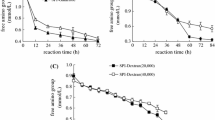Abstract
Four different WPI saccharide conjugates were successfully prepared to test whether glycation could inhibit WPI precipitation induced by trichloroacetic acid (TCA). Conjugates molecular weights after glycation were analyzed with SDS-PAGE. No significant secondary structure change due to glycation was detected. Glycation decreased the apparent denaturation enthalpy (ΔH) and increased denaturation temperature (T d). The TCA-induced WPI precipitation profiles were shown to be U-shaped. The attachment of maltodextrin and dextran increases WPI solubility against TCA-induced precipitation. However, similar effects were not observed when WPI was glycated with monosaccharide (mannose) and disaccharide (maltose), even though the degrees of glycation were significantly higher, compared to WPI-maltodextrin or WPI-dextran conjugates. The effects against precipitation depended on the molecular weight of saccharides, while the effects of the degrees of glycation were not pronounced. Steric hindrance may be the reason to inhibit TCA-induced protein precipitation after glycation. The information of this study provided may extend our knowledge about TCA-induced protein precipitation mechanism.




Similar content being viewed by others
Abbreviations
- TCA:
-
Trichloroacetic acid
- WPI:
-
Whey protein isolate
- ALA:
-
α-Lactalbumin
- BLG:
-
β-Lactoglobulin
- BSA:
-
Bovine serum albumin
- SDS-PAGE:
-
Sodium dodecyl sulfate polyacrylamide gel electrophoresis
- DSC:
-
Differential scanning calorimetry
- CD:
-
Circular dichroism
- TNBS:
-
Trinitrobenzenesulfonic acid
References
Li Y, Lu F, Luo C, Chen Z, Mao J, Shoemaker C, Zhong F (2009) Functional properties of the Maillard reaction products of rice protein with sugar. Food Chem 1171:69–74
Oliver CM, Melton LD, Stanley RA (2006) Creating proteins with novel functionality via the Maillard reaction: a review. Crit Rev Food Sci Nutr 464:337–350
Wong BT, Day L, Augustin MA (2011) Deamidated wheat protein–dextran Maillard conjugates: effect of size and location of polysaccharide conjugated on steric stabilization of emulsions at acidic pH. Food Hydrocoll 256:1424–1432
Wooster TJ, Augustin MA (2007) The emulsion flocculation stability of protein-carbohydrate diblock copolymers. J Colloid Interface Sci 3132:665–675
Lesmes U, McClements DJ (2012) Controlling lipid digestibility: response of lipid droplets coated by beta-lactoglobulin-dextran Maillard conjugates to simulated gastrointestinal conditions. Food Hydrocolloids 261:221–230
Xue J, Tan C, Zhang X, Feng B, Xia S (2014) Fabrication of epigallocatechin-3-gallate nano-carrier based on glycosylated casein: stability and interaction mechanism. J Agric Food Chem 62(20):4677–4684
Isaacson T, Damasceno CMB, Saravanan RS, He Y, Catala C, Saladie M, Rose JKC (2006) Sample extraction techniques for enhanced proteomic analysis of plant tissues. Nat Protoc 12:769–774
Jiang L, He L, Fountoulakis M (2004) Comparison of protein precipitation methods for sample preparation prior to proteomic analysis. J Chromatogr A 10232:317–320
Zhong C, Wang R, Zhou Z, Jia S-R, Tan Z-L, Han P-P (2012) Functional properties of protein isolates from Caragana korshinskii Kom. Extracted by three different methods. J Agric Food Chem 6041:10337–10342
Rajalingam D, Loftis C, Xu JJ, Kumar TKS (2009) Trichloroacetic acid-induced protein precipitation involves the reversible association of a stable partially structured intermediate. Protein Sci 185:980–993
Liu G, Zhong Q (2013) Thermal aggregation properties of whey protein glycated with various saccharides. Food Hydrocoll 321:87–96
Dyballa N, Metzger S (2009) Fast and sensitive colloidal coomassie G-250 staining for proteins in polyacrylamide gels. J Vis Exp 30:1431
Habeeb AFS (1966) Determination of free amino groups in proteins by trinitrobenzenesulfonic acid. Anal Biochem 143:328–336
Sagar AJ, Pandit MW (1983) Denaturations studies on bovine pancreatic ribonuclease: effect of trichloroacetic acid. Biochim Biophys Acta 743(3):303–309
Livney YD (2010) Milk proteins as vehicles for bioactives. Curr Opin Colloid Interface Sci 151–2:73–83
Whitmore L, Wallace BA (2008) Protein secondary structure analyses from circular dichroism spectroscopy: methods and reference databases. Biopolymers 895:392–400
Enomoto H, Li C-P, Morizane K, Ibrahim HR, Sugimoto Y, Ohki S, Ohtomo H, Aoki T (2007) Glycation and phosphorylation of β-lactoglobulin by dry-heating: effect on protein structure and some properties. J Agric Food Chem 556:2392–2398
Kato A (2002) Industrial applications of Maillard-type protein-polysaccharide conjugates. Food Sci Technol Res 83:193–199
Guo X, Xiong YL (2013) Characteristics and functional properties of buckwheat protein–sugar Schiff base complexes. LWT-Food Sci Technol 512:397–404
Sivaraman T, Kumar TKS, Jayaraman G, Yu C (1997) The mechanism of 2,2,2-trichloroacetic acid-induced protein precipitation. J Protein Chem 164:291–297
Kumar TKS, Subbiah V, Ramakrishna T, Pandit MW (1994) Trichloroacetic acid-induced unfolding of bovine pancreatic ribonuclease: existence of molten globule-like state. J Biol Chem 26917:12620–12625
Delahaije RJBM, Gruppen H, van Nieuwenhuijzen NH, Giuseppin MLF, Wierenga PA (2013) Effect of glycation on the flocculation behavior of protein-stabilized oil-in-water emulsions. Langmuir 2949:15201–15208
Acknowledgments
This work was financially supported by National 125 Program 2011BAD23B02, 2013AA1022207; NSFC 31171686 and 31401533; NSF-Jiangsu-BK2012556; 111 Project B07029; PCSIRT0627 and JUSRP11422.
Conflict of interest
None.
Compliance with Ethics Requirements
This article does not contain any studies with human or animal subjects.
Author information
Authors and Affiliations
Corresponding author
Additional information
Mention of trade names or commercial products in this publication is solely for the purpose of providing specific information and does not imply recommendation or endorsement by the U.S. Department of Agriculture.
Rights and permissions
About this article
Cite this article
Yi, J., Zhang, Y., Yokoyama, W. et al. Glycation inhibits trichloroacetic acid (TCA)-induced whey protein precipitation. Eur Food Res Technol 240, 847–852 (2015). https://doi.org/10.1007/s00217-014-2391-9
Received:
Revised:
Accepted:
Published:
Issue Date:
DOI: https://doi.org/10.1007/s00217-014-2391-9




